GMC SIERRA 1993 Owners Manual
Manufacturer: GMC, Model Year: 1993, Model line: SIERRA, Model: GMC SIERRA 1993Pages: 436, PDF Size: 23.88 MB
Page 191 of 436
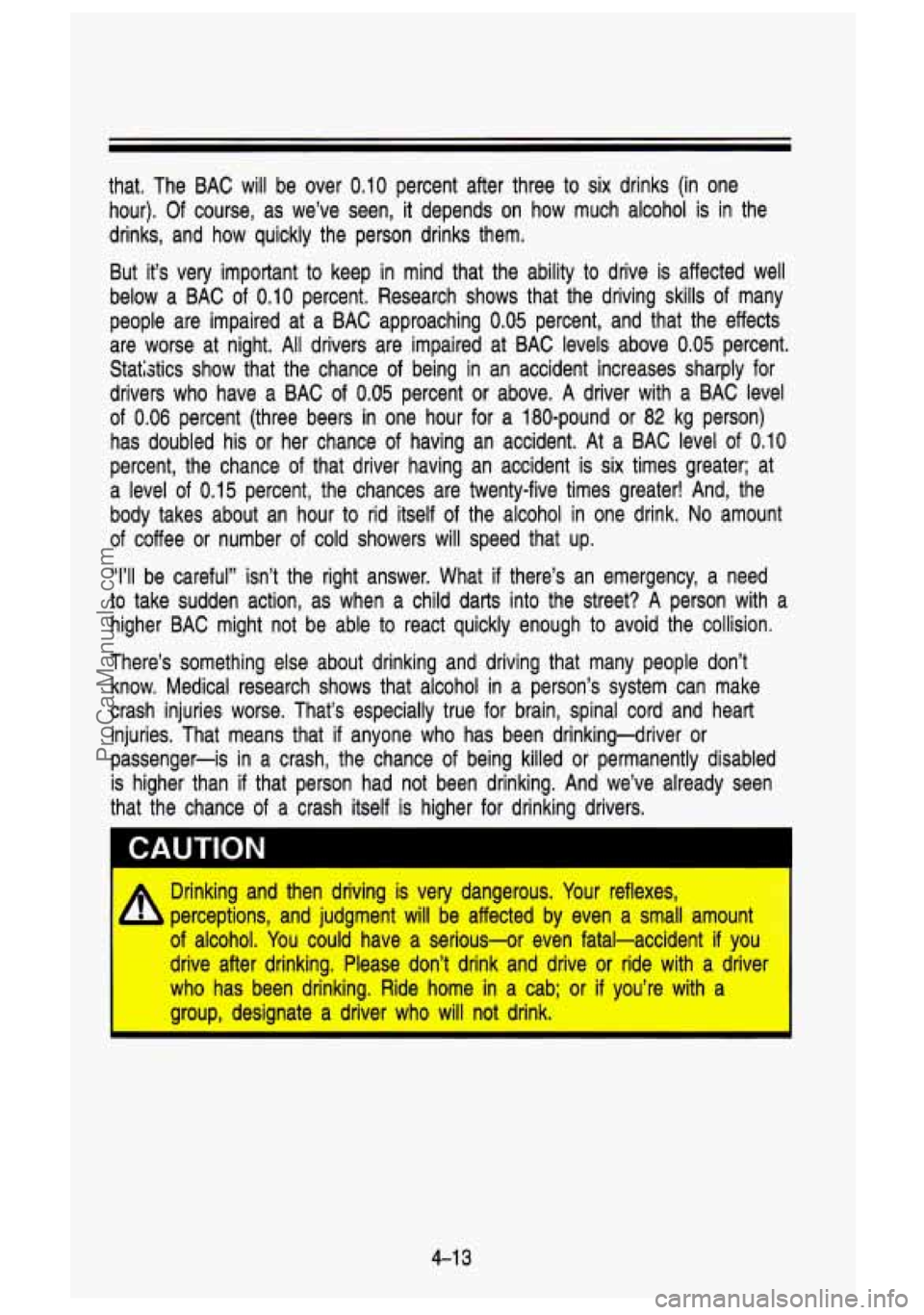
that. The BAC will be over 0.10 percent after three to six drinks (in one
hour).
Of course, as we’ve seen, it depends on how much alcohol is in the
drinks, and how quickly the person drinks them.
But it’s very important to keep in mind that the ability to drive is affected well
below a BAC of
0.10 percent. Research shows that the driving skills of many
people are impaired at a BAC approaching
0.05 percent, and that the effects
are worse at night. All drivers are impaired at BAC levels above
0,05 percent.
Statistics show that the chance of being in an accident increases sharply for
drivers who have a BAC of
0.05 percent or above. A driver with a BAC level
of
0.06 percent (three beers in one hour for a 180-pound or 82 kg person)
has doubled his or her chance of having an accident. At a BAC level of 0.10
percent, the chance of that driver having an accident is six times greater; at
a level of
0.15 percent, the chances are twenty-five times greater! And, the
body takes about an hour to rid itself of the alcohol in one drink.
No amount
of coffee or number
of cold showers will speed that up.
“1’11 be careful” isn’t the right answer. What if there’s an emergency, a need
to take sudden action, as when a child darts into the street?
A person with a
higher BAC might not be able to react quickly enough to avoid the collision.
There’s something else about drinking and driving that many \
people don’t know. Medical research shows that alcohol in a person’s system can make
crash injuries worse. That’s especially true for brain, spinal cord and heart
injuries. That means that
if anyone who has been drinking-driver or
passenger-is in a crash, the chance of being killed or permanently disabled
is higher than
if that person had not been drinking. And we’ve already seen
that the chance of
a crash itself is higher for drinking drivers.
CAUTION
A Drinking and then driving is very dangerous. Your reflexes,
- perceptions, and judgment will be affected by even a small amount
of alcohol. You could have a serious-or even fatal-accident
if you
drive after drinking. Please don’t drink and drive or ride with a driver
who has been drinking. Ride home in a cab; or
if you’re with a
group, designate a driver who will not drink.
4-1
3
ProCarManuals.com
Page 192 of 436
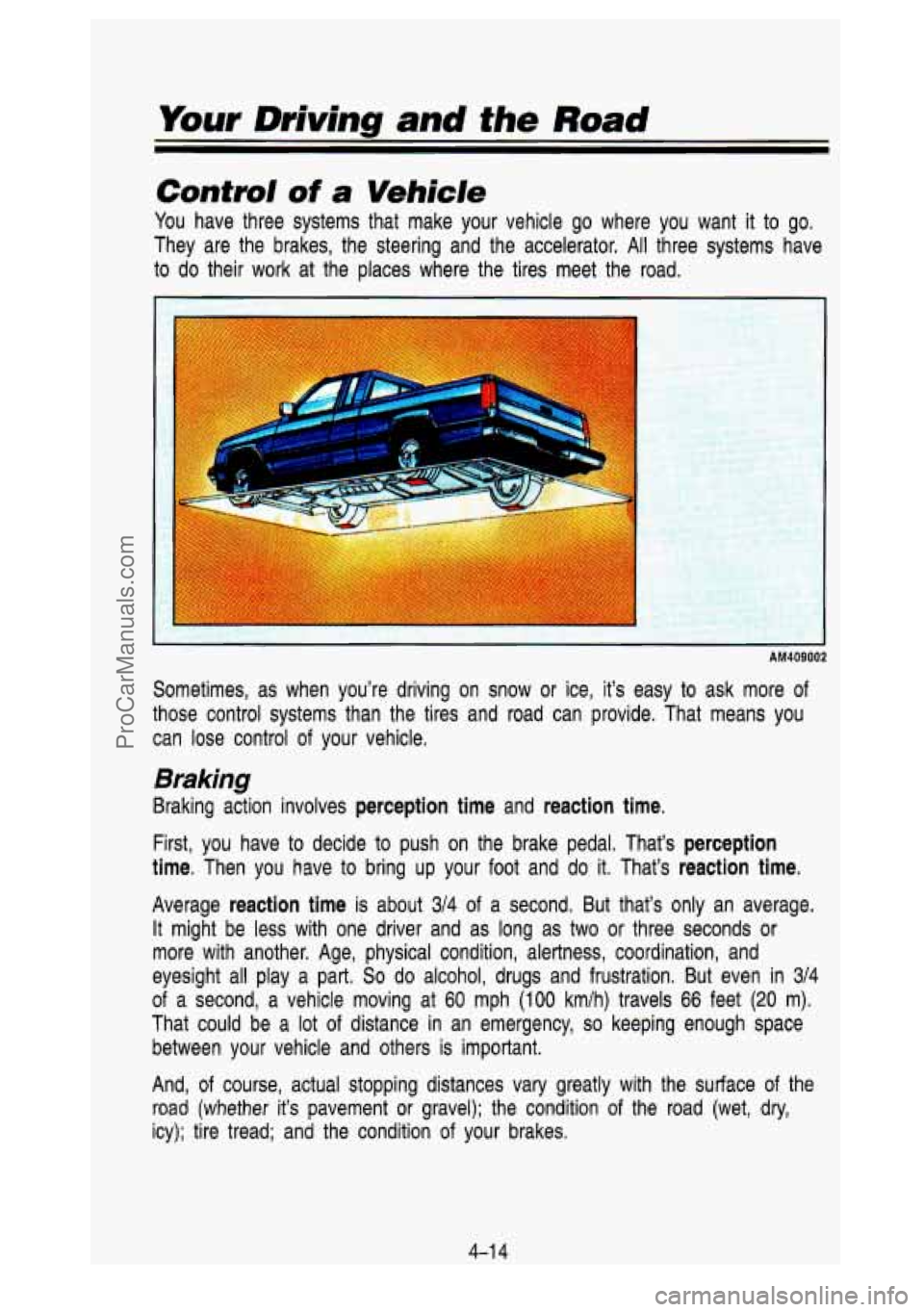
Your Driving and the Road
Control of a Vehicle
You have three systems that make your vehicle go where you want it to go.
They are the brakes, the steering and the accelerator.
All three systems have
to
do their work at the places where the tires meet the road.
AM409002
Sometimes, as when you’re driving on snow or ice, it’s e\
asy to ask more of
those control systems than the tires and road can provide. Tha\
t means you can
lose control of your vehicle.
Braking
Braking action involves perception time and reaction time.
First, you have to decide to push on the brake pedal. That’s perception
time.
Then you have to bring up your foot and do it. That’s reaction time.
Average reaction time is about 314 of a second. But that’s only an average.
It might be less with one driver and as long as two or thre\
e seconds or
more with another. Age, physical condition, alertness, coordinati\
on, and
eyesight all play a part.
So do alcohol, drugs and frustration. But even in 3/4
of a second, a vehicle moving at 60 mph (100 km/h) travels 66 feet (20 m).
That could be a lot
of distance in an emergency, so keeping enough space
between your vehicle and others
is important.
And, of course, actual stopping distances vary greatly with the surface of the
road (whether it’s pavement or gravel); the condition of the road (wet, dry,
icy): tire tread; and the condition of your brakes,
4-1 4
ProCarManuals.com
Page 193 of 436
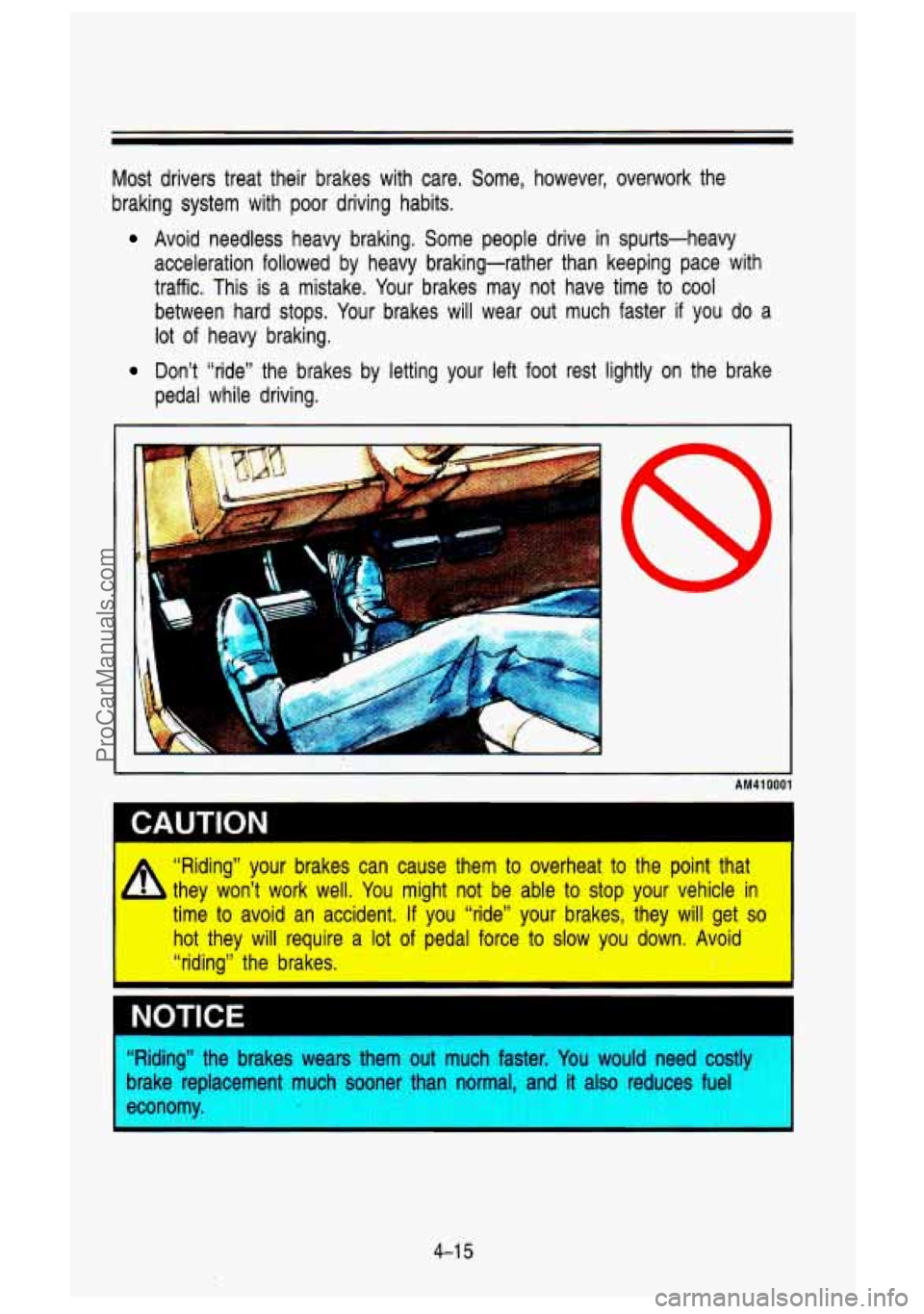
Most drivers treat their brakes with care. Some, however, overw\
ork the
braking system with poor driving habits.
Avoid needless heavy braking. Some people drive in spurts-heavy
acceleration followed by heavy braking-rather than keeping pace with
traffic. This is
a mistake. Your brakes may not have time to cool
between hard stops. Your brakes will wear out much faster
if you do a
lot of heavy braking.
Don’t “ride” the brakes by letting your left foot rest\
lightly on the brake
pedal while driving.
I
I
AM410001
CAUTION I
1 “Riding” your brakes can cause them to overheat to the point that
- they won’t work well. You might not be able to stop your vehicle in
time to avoid an accident. If you “ride” your brakes, they will get
so
hot they will require a lot of pedal force to slow you down. Avoid
“riding” the brakes.
NOTICE
“Riding” the brakes wears them out much faster. You would need costly
brake replacement much sooner than normal. and it also reduces fuel
economv.
4-1 5
ProCarManuals.com
Page 194 of 436
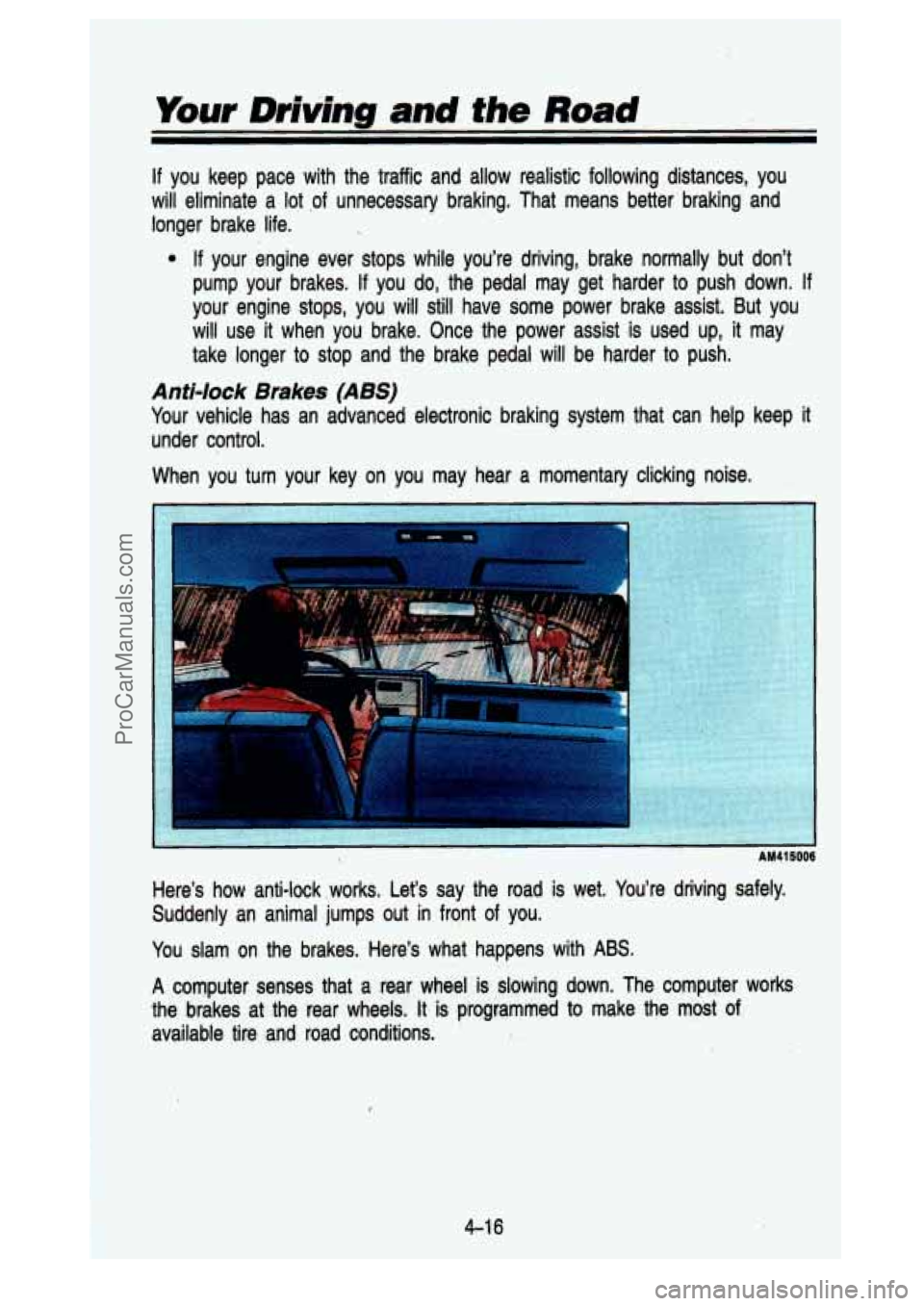
If you keep pace with the traffic and alllow realieti~ following dbtances, ‘you
will eliminate a lot .of unnecessary braking.. That means - better brakin’g . and
longer brake life;
,* If your engine ever stops while- you’re driving, brake normally but don’t
pump your brakes. If you do, tht$ pedal may get harder to. .push down. If
your- engine stops, you will still have some power $rake, assist But you
will use it when you brake. Once the power assist =is used ‘up, it may
take longer to stop and the brake pedal will be harder to push.
Anti-lock Brakes (ABS)
Your vehicl’e has an ‘advanced electronic braking system that can help keep it
under Control.
When you turn your key on you m.ay .hear a momentary clicking ngise. , ,.
Here’s I how anti-lock .works. Let’s say the road is wet. You’re d.rivilng. sifely.
Suddenly an animal jumps out In frqnt of you.
ProCarManuals.com
Page 195 of 436
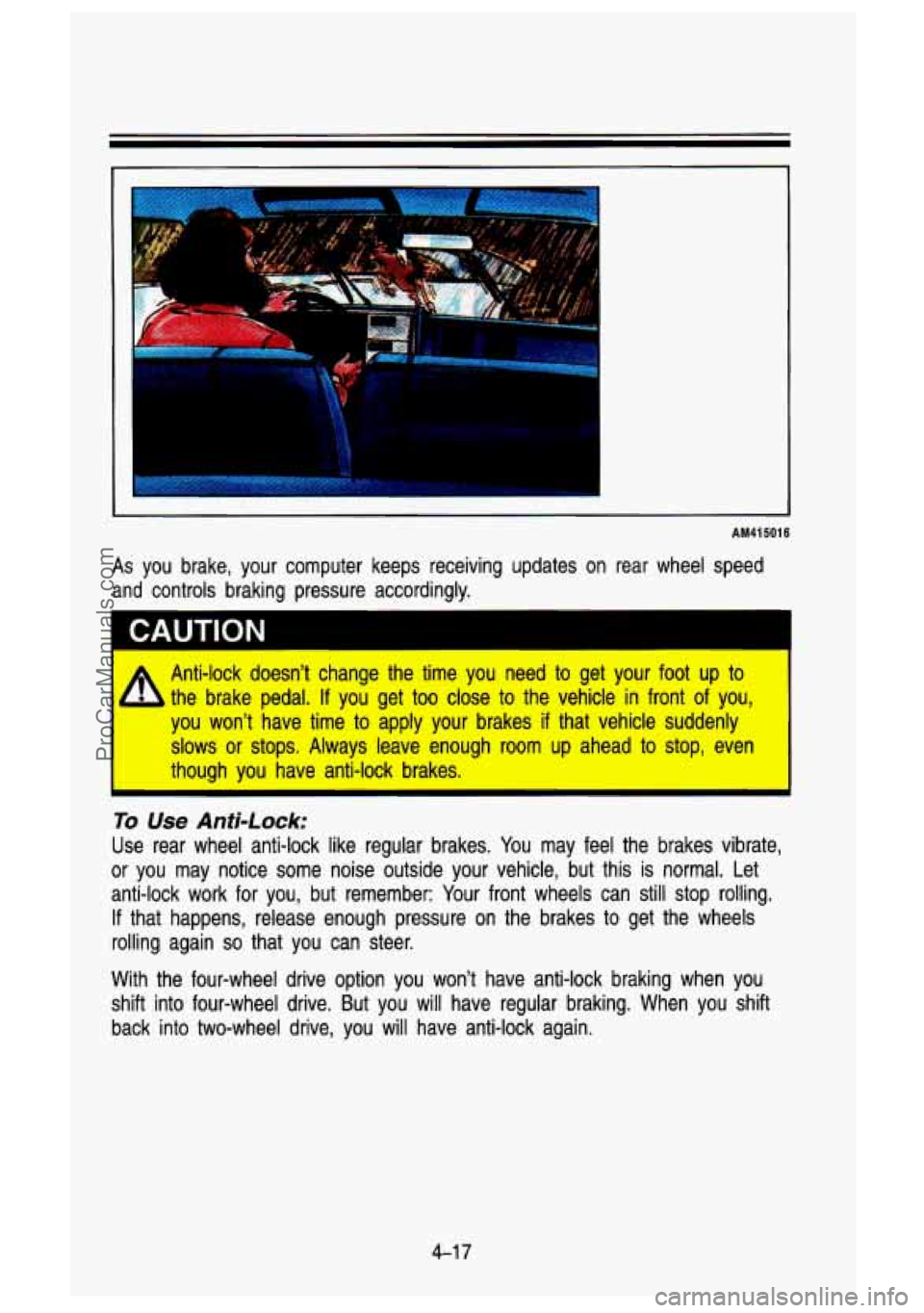
c
AM41 501 6
As you brake, your computer keeps receiving updates on rear wheel spee\
d
and controls braking pressure accordingly.
CAUTION I
A
Anti-lock doesn’t change the time you need to get your foot up to I
the brake pedal. If you get too close to the vehicle in front of you,
you won’t have time
to apply your brakes if that vehicle suddenly
slows or stops. Always leave enough room up ahead to stop, even
though you have anti-lock brakes.
To Use Anti-Lock:
Use rear wheel anti-lock like regular brakes. You may feel the brakes vibrate,
or you may notice some noise outside your vehicle, but this is normal. Let
anti-lock work for you, but remember: Your front wheels can still stop rolling.
If that happens, release enough pressure on the brakes to get the wheels
rolling again
so that you can steer.
With the four-wheel drive option you won’t have anti-lock braking when you
shift into four-wheel drive. But you will have regular braking. When you shift
back into two-wheel drive, you will have anti-lock again.
4-1 7
ProCarManuals.com
Page 196 of 436
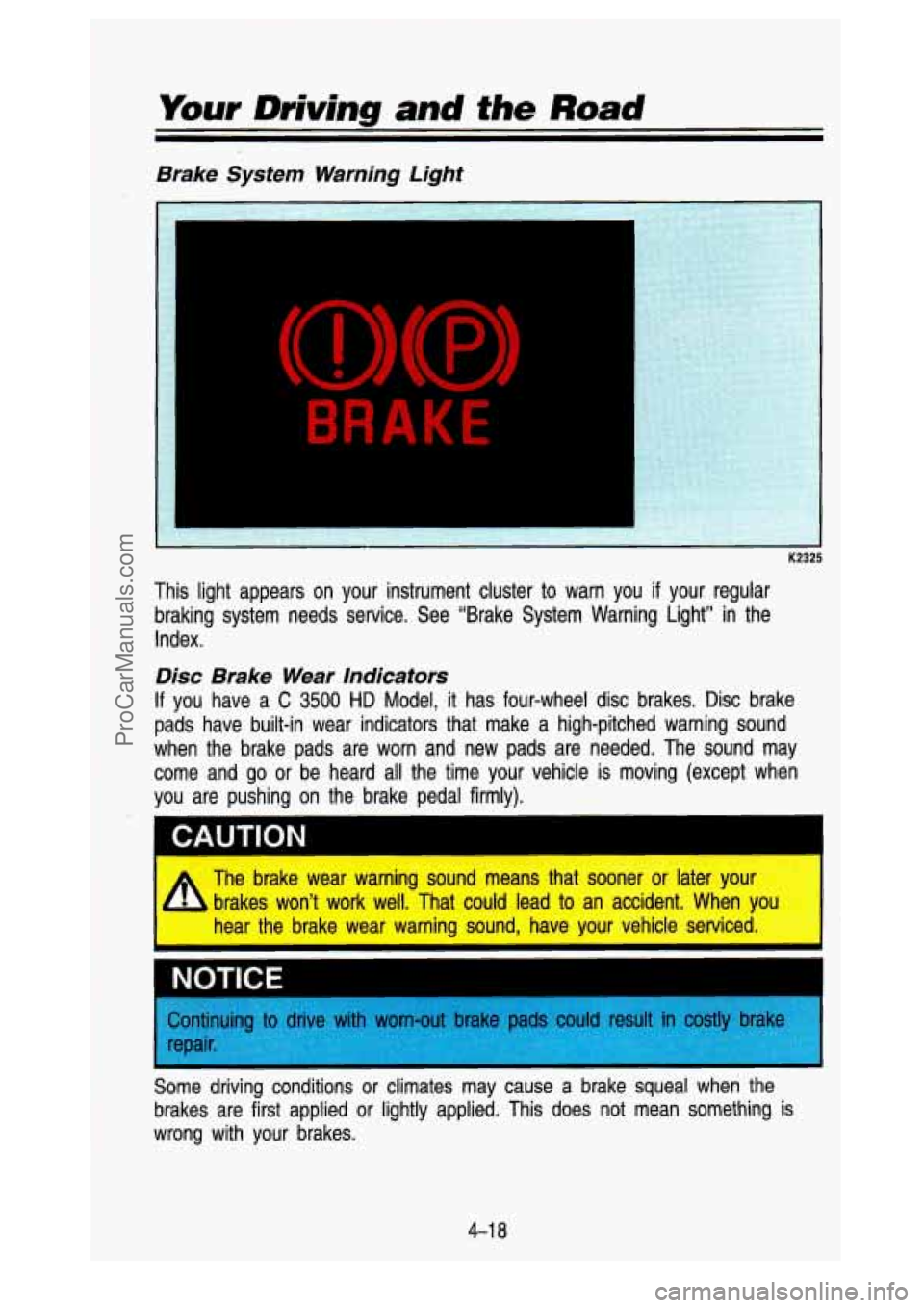
Your Driving and fhe Road
Brake System Warning Light
K2325
This light appears on your instrument cluster to warn you if your regular
braking’ system needs service. See “Brake System Warning L\
ight” in the
Index.
Disc Brake Wear Indicators
If you have a C 3500 HD Model, it has four-wheel disc brakes. Disc brake
pads have built-in wear indicators that make a high-pitched war\
ning sound
when the brake pads are worn and new pads are needed. The so\
und m’ay
come and go or be heard all the time your vehicle is moving (except \
when
you are pushing on the brake pedal firmly).
1 CAUTION
The brake wear warning sound means that sooner or later your
hear the brake wear warning sound, have your vehicle serviced. \
5 brakes won’t work well. That could lead to an accident. When you I ~
I 1
i
~ i
brakes are first applied or lightly applied. This does not mea\
n something is
wrong with your brakes.
4-1 8
ProCarManuals.com
Page 197 of 436
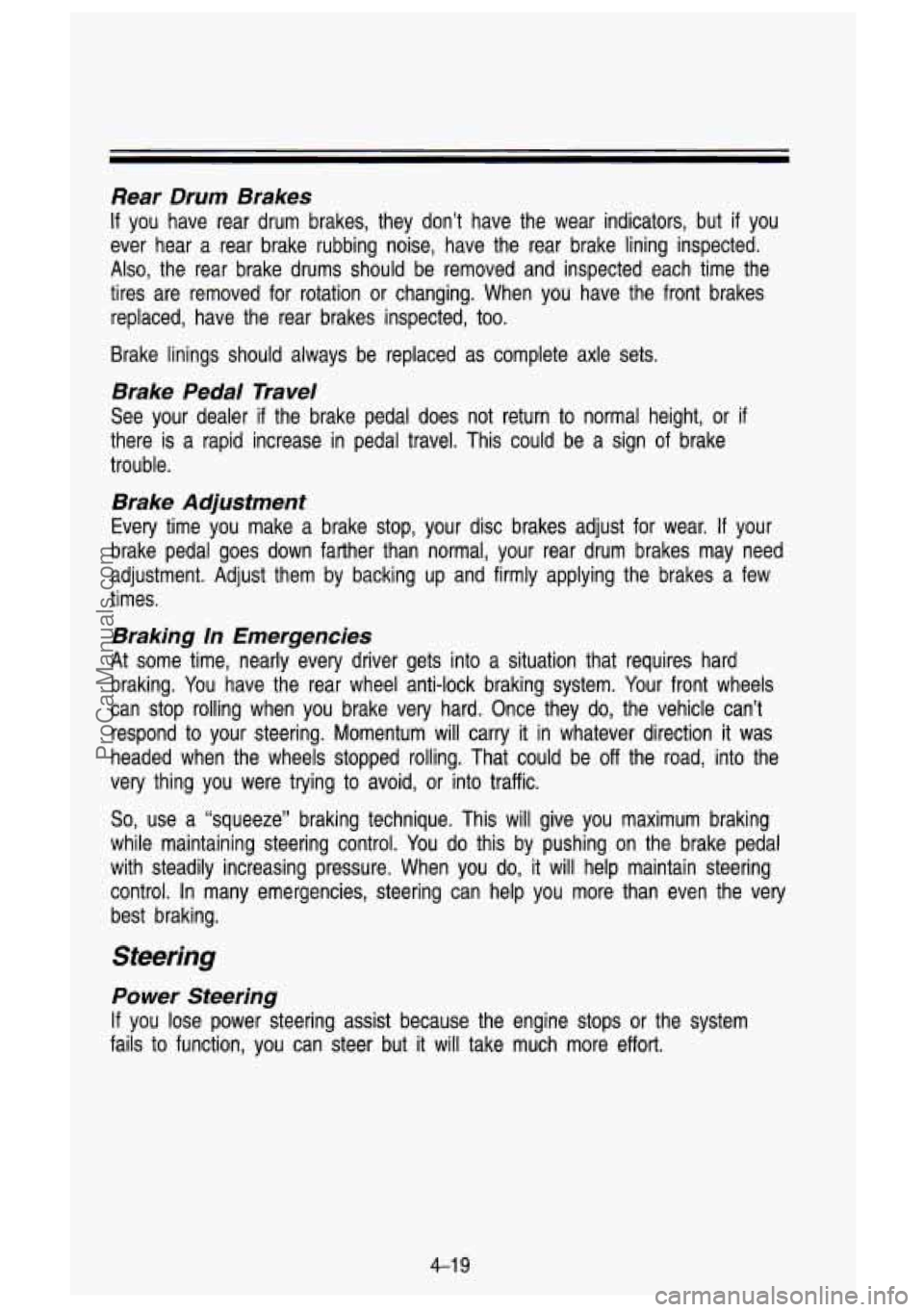
Rear Drum Brakes
If you have rear drum brakes, they don’t have the wear indicators, \
but if you
ever hear a rear brake rubbing noise, have the rear brake lining inspected.
Also, the rear brake drums should be removed and inspected each time\
the
tires are removed for rotation or changing. When you have the \
front brakes replaced, have the rear brakes inspected, too.
Brake linings should always be replaced as complete axle sets.
Brake Pedal Travel
See your dealer if the brake pedal does not return to normal height, or if
there is a rapid increase in pedal travel. This could be a sign of brake
trouble.
Brake Adjusiment
Every time you make a brake stop, your disc brakes adjust for\
wear. If your
brake pedal goes down farther than normal, your rear drum brak\
es may need
adjustment. Adjust them by backing up and firmly applying the brakes a few
times.
Braking In Emergencies
At some time, nearly every driver gets into a situation that requires hard
braking. You have the rear wheel anti-lock braking system. Your front wheels
can stop rolling when you brake very hard. Once they
do, the vehicle can’t
respond to your steering. Momentum will carry it in whatever direction it was
headed when the wheels stopped rolling. That could be off the \
road, into the
very thing you were trying to avoid, or into traffic.
So, use a “squeeze” braking technique. This will give you max\
imum braking
while maintaining steering control. You
do this by pushing on the brake pedal
with steadily increasing pressure. When you
do, it will help maintain steering
control. In many emergencies, steering can help you more than even the very
best braking.
Steering
Power Sieerhg
If you lose power steering assist because the engine stops or \
the system
fails to function, you can steer but it will take much more effort.
4-1 9
ProCarManuals.com
Page 198 of 436
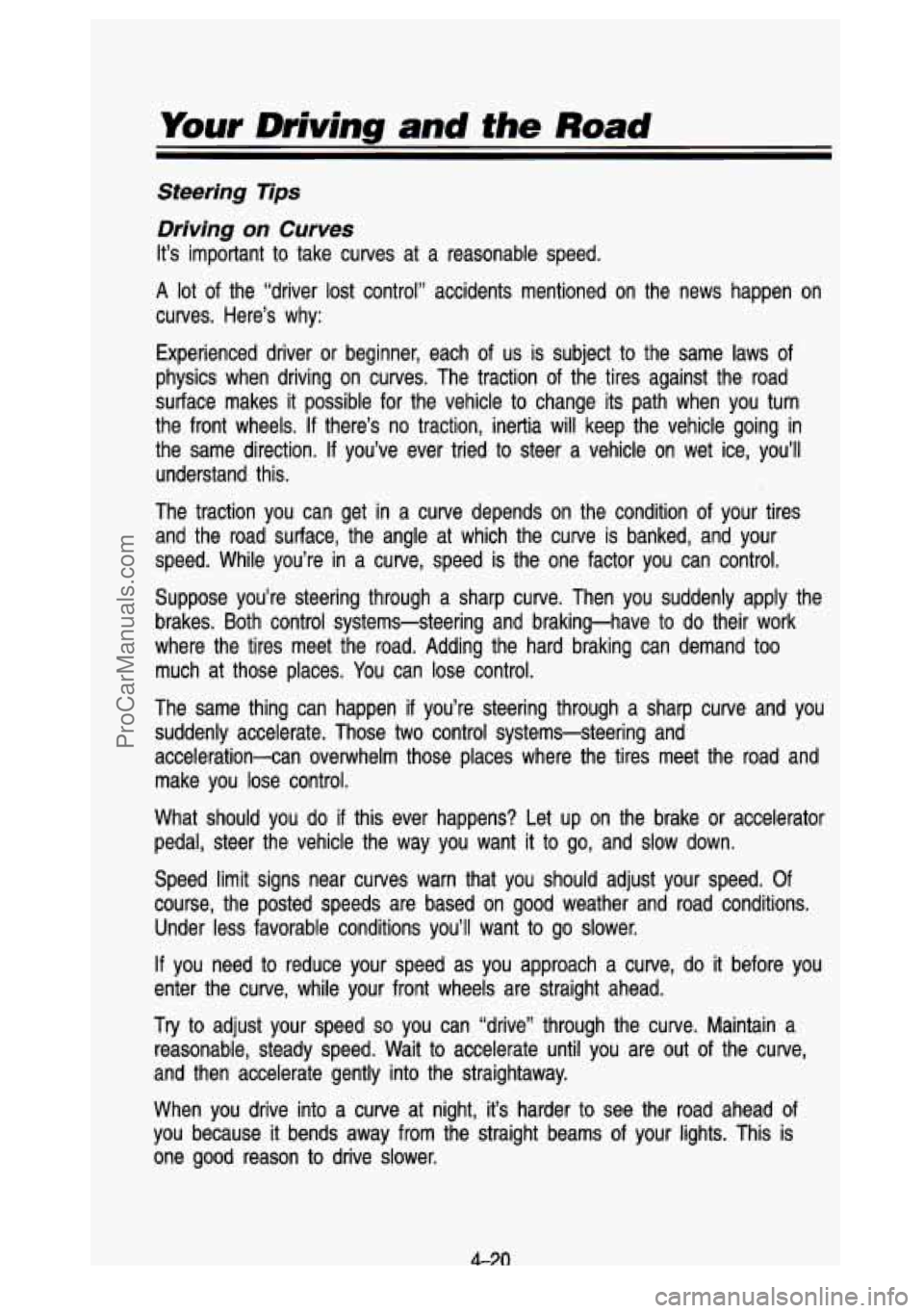
Your Driving and the Road
Steering Tips Driving
on Curves
It’s important to take curves at a reasonable speed.
A lot of the “driver lost control” accidents mentioned on the news \
happen on
curves. Here’s why:
Experienced driver or beginner, each of us is subject to the same laws
of
physics when driving on curves. The traction of the tires against the road
surface makes it possible for the vehicle to change its path when you turn
the front wheels.
If there’s no traction, inertia will keep the vehicle going in
the same direction.
If you’ve ever tried to steer a vehicle on wet ice, you’ll
understand this.
The traction you can get in a curve depends on me condition of your tires
and the road surface, the angle at which the curve is banked,\
and your
speed. While you’re in a curve, speed is the one factor you can control.
Suppose you’re steering through a sharp curve. Then you sudd\
enly apply the
brakes. Both control systems-steering and braking-have to
do their work
where the tires meet the road. Adding the hard braking can de\
mand too
much at those places. You can lose control.
The same thing can happen
if you’re steering through a sharp curve and you
suddenly accelerate. Those two control systems-steering and
acceleration-can overwhelm those places where the tires meet the road and
make you lose control.
What should you
do if this ever happens? Let up on the brake or accelerator
pedal, steer the vehicle the way you want it to
go, and slow down.
Speed limit signs near curves warn that you should adjust your\
speed. Of
course, the posted speeds are based on
good weather and road conditions.
Under less favorable conditions you’ll want to go slower.
If you need to reduce your speed as you approach a curve, do it before you
enter the curve, while your front wheels are straight ahead.
Try to adjust your speed
so you can “drive” through the curve. Maintain a
reasonable, steady speed. Wait to accelerate until you are out of the curve,
and then accelerate gently into the straightaway.
When you drive into a curve at night, it’s harder
to see the road ahead of
you because it bends away from the straight beams
of your lights. This is
one good reason to drive slower.
4-20
ProCarManuals.com
Page 199 of 436
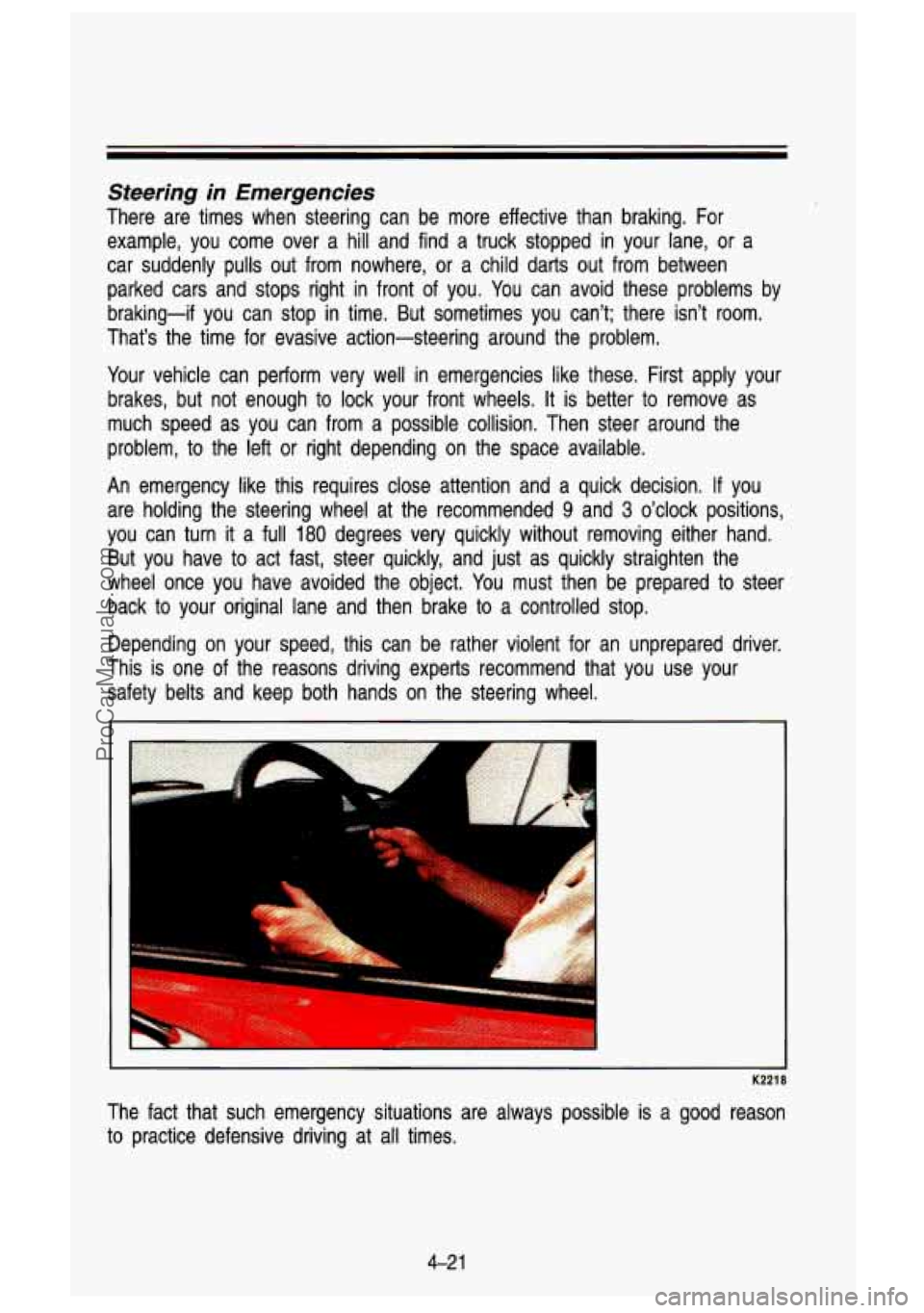
Steering in Emergencies
There are times when steering can be more effective than braki\
ng. For example, you come over a hill and find a truck stopped in yo\
ur lane, or a
car suddenly pulls out from nowhere, or a child darts out fro\
m between parked cars and stops right in front of you. You can avoid these problems by
braking-if you can stop in time. But sometimes you can't; ther\
e isn't room.
That's the time for evasive action-steering around the problem. \
Your vehicle can perform very well in emergencies like these. First \
apply your
brakes, but not enough to lock your front wheels. It is better to remove as
much speed as you can from a possible collision. Then steer around the
problem, to the left or right depending on the space available\
.
An emergency like this requires close attention and a quick decision. If yo\
u
are holding the steering wheel at the recommended
9 and 3 o'clock positions,
you can turn
it a full 180 degrees very quickly without removing either hand.
But you have to act fast, steer quickly, and just as quickly \
straighten the
wheel once you have avoided the object. You must then be prep\
ared to steer
back to your original lane and then brake to a controlled stop.
Depending on your speed, this can be rather violent for an un\
prepared driver.
This is one of the reasons driving experts recommend that you use your
safety belts and keep both hands on the steering wheel.
K2218
The fact that such emergency situations are always possible is \
a good reason
to practice defensive driving at
all times.
4-2 1
ProCarManuals.com
Page 200 of 436
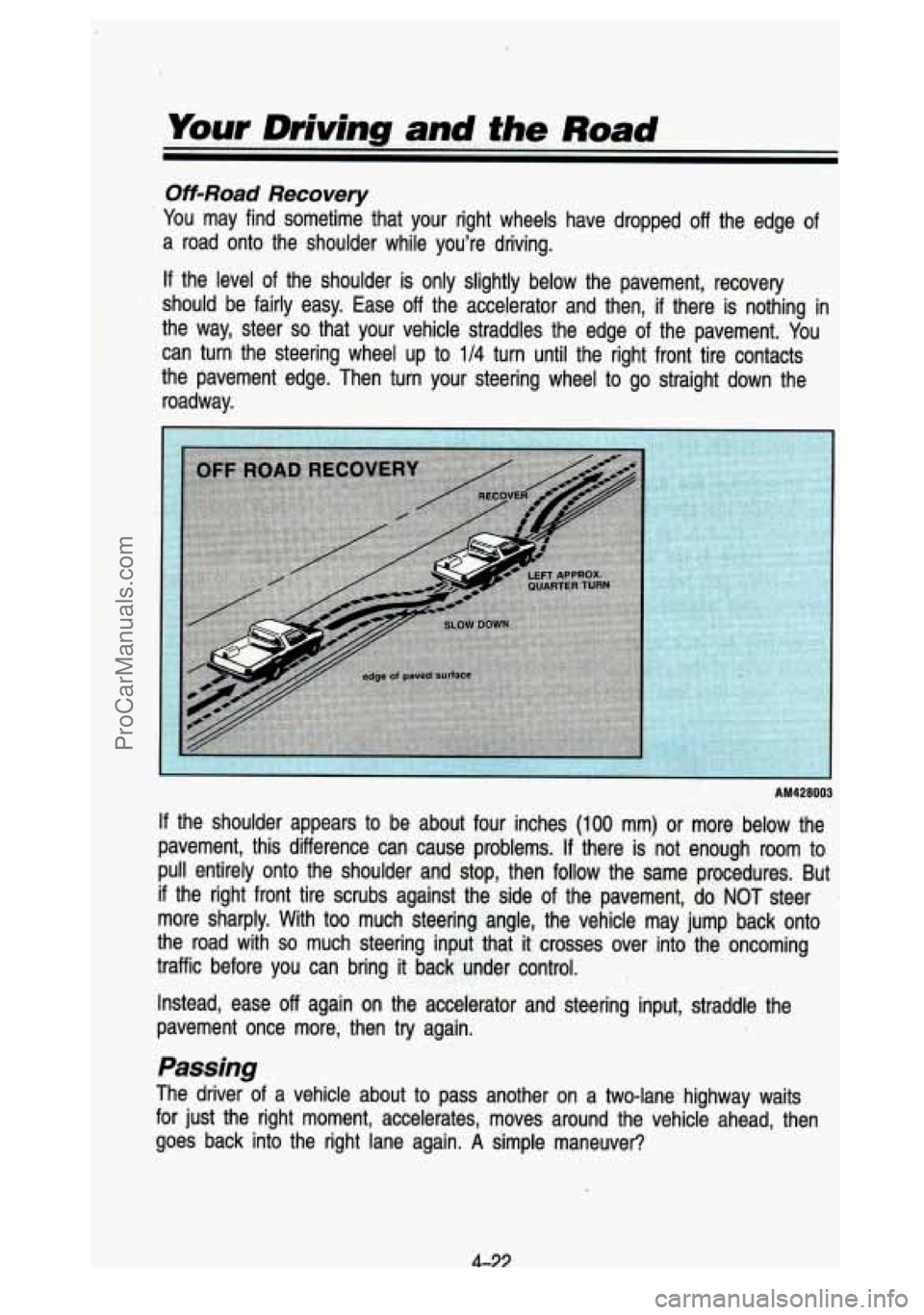
Your Drivm - and the Road.
Off-Road Recovery
You may find. sometime that your right wheels have dropped off the edge of
a road onto the shoulder while you're driving.
If the level of the shoulder is only slightly below the pavement, recovery
should be fairly easy. Ease
off the accelerator and then, if there is nothing in
the way, steer
'so that your vehicle straddles the edge of the pavement. You
can turn the steering wheel up to
1/4 turn until the right front tire contacts
the pavement edge. Then turn your steering wheel to go straight down the
roadway.
AM428003
If the shoulder appears to be about four inches (100 mm) or more below the
pavement, this difference can .cause problems.
If there is not enough room to
pull entirely onto the shoulder and stop, then follow the same proc\
edures. But
if the right front tire scrubs against the side of the pavement, do NOT steer
more sharply. With
too much steering angle, the vehicle may jump back onto
the road with
so much steering input that it crosses over .into the oncoming
traffic before you can bring
it back under control.
Instead, ease off again on the accelerator and steering input, \
straddle the
pavement once more, then
try again.
Passing
The driver of a vehicle about to pass another on a two-lane highway waits
for just the right moment, accelerates, moves around the vehicl\
e ahead, then
goes back into the right lane again.
A simple maneuver?
4-22
ProCarManuals.com